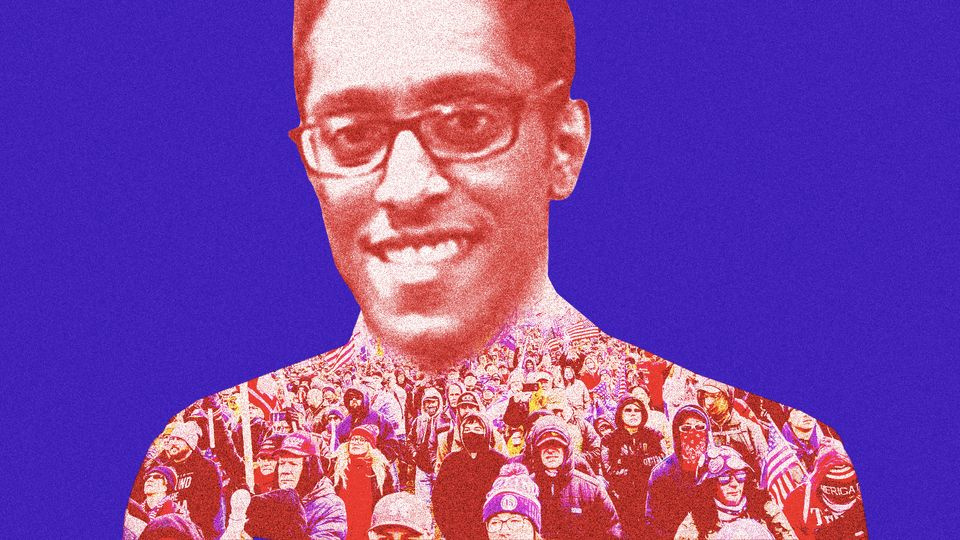How Republican Politics (And Twitter) Created Ali Alexander, The Man Behind
Illustration:Rebecca Zisser/HuffPost; Photo: Getty
High above Constitution Avenue, on a rooftop terrace, “Stop the Steal” organizer Ali Alexander gazed down at the U.S. Capitol and the chaos he’d helped unleash.
A mob of President Donald Trump’s supporters had just stormed the U.S. Capitol, forcing members of Congress to scramble for safety. White nationalists, QAnon cultists and Make America Great Again extremists roamed the halls hunting for politicians. Some carried zip-tie handcuffs. One wore a sweatshirt that read “Camp Auschwitz.”
“I don’t disavow this,” Alexander said, pointing to the scene below.
The longtime Republican political operative had spent months working with Rep. Paul Gosar (R-Ariz.) and far-right activists, such as Mike Cernovich, to organize nationwide protests aimed at invalidating Democrat Joe Biden’s presidential win. Alexander knew plenty of influential Republicans, like Sen. Ted Cruz (R-Texas), who led an effort in the Senate to dispute the election results. He had connections to the Republican Attorneys General Association, which was also involved in promoting the rally-turned-riot.
Alexander had plenty of friends in low places, too: far-right Twitter influencers and grifters; members of the violent neo-fascist Proud Boys gang who showed up at his protests; Nick Fuentes, a prominent far-right extremist who participated in 2017’s deadly “Unite the Right” rally in Charlottesville, Virginia. Fuentes said in 2019 that he could accurately be described as a white nationalist, being both “white” and a “nationalist,” and just two days before the riot he seemingly encouraged his followers to kill legislators.
Get the top stories emailed every day. Newsletters may offer personalized content or advertisements.
Privacy Policy
Unsurprisingly, several of Alexander’s previous Stop the Steal events had inspired bloodshed. But none of them ― and nothing in American history ― compared to what happened Jan. 6.
The warning signs were ominous. Before the rally, white nationalists and militia members talked about smuggling guns into D.C. Pro-Trump internet forums crackled with homicidal chatter and plans to lay siege to the Capitol. And the Proud Boys were back in town. They’d turned out by the hundreds for Alexander’s two other Stop the Steal events in Washington. Brawls and stabbings occurred after those demonstrations. The Proud Boys attacked residents. In December, they ripped a Black Lives Matter banner off a Black church and burned it in the street. Their leader, Enrique “Henry” Tarrio, was arrested on Jan. 4 with high-capacity firearms magazines as he entered the city.
At the rally, the president whipped up demonstrators with a speech on the White House Ellipse, where Alexander had a front-row seat. “We will not take it anymore,” Trump said. “We will stop the steal.” The demagogue then pointed his supporters toward the heart of American democracy.
The mob arrived at the Capitol just before 1 p.m. Insurrectionists smashed through barricades and police lines. Once inside, they looted and vandalized. They urinated and defecated on floors. One of them scrawled “Murder the media” on a set of doors. Many were far-right extremists, including a Proud Boy allegedly looking to kill then-Vice President Mike Pence. Men carrying a flag from Fuentes’ “America First” group prowled through the building. Another Alexander associate, Tim “Baked Alaska” Gionet, a veteran of the Charlottesville rally, livestreamed himself inside the Capitol and was later arrested.
But it was the fate of Ashli Babbitt, a military veteran and QAnon conspiracy theory devotee, that crystallized to what lengths some would go on behalf of Trump. On Twitter, Babbitt was in thrall to MAGA propagandists and Stop the Steal organizers such as Jack Posobiec — one of Alexander’s close friends and a prolific spreader of disinformation, including the Pizzagate sex trafficking conspiracy theory that in 2016 resulted in a pro-Trump gunman storming a restaurant in Washington, D.C. On Jan. 5, Posobiec tweeted a photo of a plane loaded with Trump supporters traveling to Washington and described them, seemingly in jest, as “domestic terrorists.” Babbitt retweeted the message. It was her penultimate act on a platform that helped radicalize her.
The next day, she stormed the Capitol and tried to force her way through a broken window into the House chamber. A Capitol Police officer shot her in the neck. Babbitt died.
Police would later find pipe bombs outside the Democratic National Committee and Republican National Committee offices. They’d find Molotov cocktails in a nearby truck. National security experts declared the attack domestic terrorism. Seven people died in the…
Read More: How Republican Politics (And Twitter) Created Ali Alexander, The Man Behind


